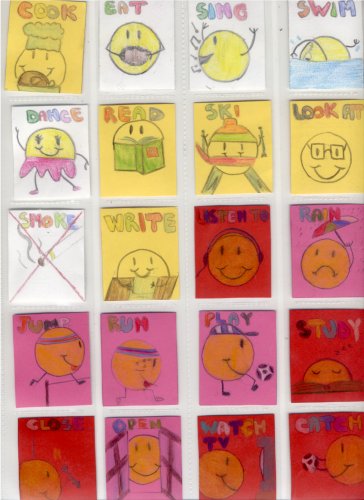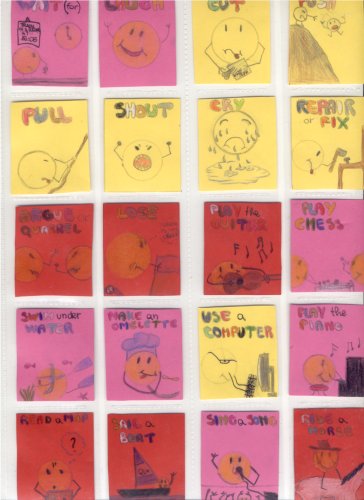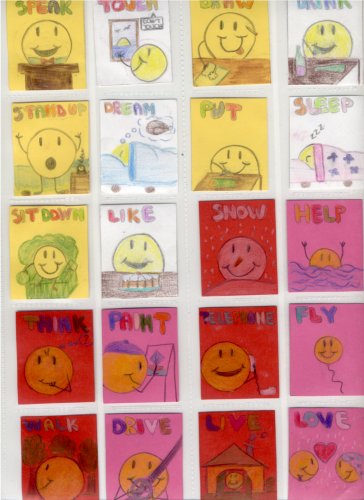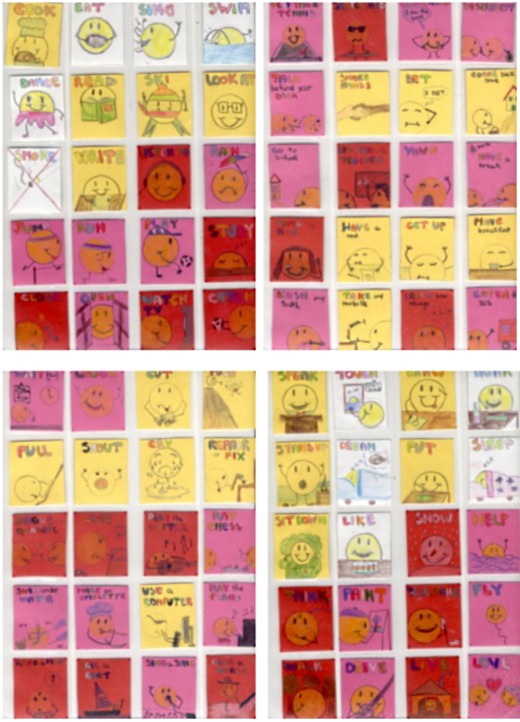EMO-TIONAL Verb Cards - Ideas for Teaching Vocabulary
Daniela Tomatis, Italy
Daniela Tomatis is a teacher at Scuola Media Villanova Mondovì, Cuneo, in the north of Italy. She is interested in vocabulary teaching and memory techniques. She enjoys trying new activities.
E-mail: dan.ro@tiscalinet.it
Menu
Introduction
Starting point – Emo cards
Suggested activities
Working alone
Working in groups
Working in pairs
Working with the whole class
References
Teaching a word does not cause its automatic learning by the students. That is one of the first things teachers realise when they start teaching. It would be wonderful if finishing a unit of the course book meant that the students master all the words in it. Unfortunately, a lot of work ( recycling, vocabulary notebooks keeping, memory techniques ...) has to be done before students thoroughly know a word. The activities which follow have been tested on beginner students aged 11-14 and provide a practical suggestion for a systematic approach to vocabulary learning.
Whenever we find a new verb during the lessons, Ss are asked to make small cards of the verbs in order not to forget them and to help them pass from the recognition stage to the production one.
These cards have the ENGLISH word on one side and its TRANSLATION on the other. Here is an example of a set of cards where each verb has been represented using an emoticon.




Students can choose how to draw their verbs, kinds of picture, stickmen, - also images which work as reminders for the keywords, when they memorize the verbs using this technique. Anyway, most of them like the idea of emoticons. They are easy to draw, nice and can foster creativity. That’s the way students learn and remember verbs, and it is a consistent part of vocabulary building. It is worth spending time having them personalize their work which leads to personalizing their learning. Moreover, visualization involves creating images in our brains which helps build a good memory. Last but not least, in this way the students have a clear awareness of how many verbs they know, or should know, and so has the teacher, and also an easily accessible stock which can be used for future reference and for revising .

Students learn best by making sense of their own vocabulary and internalising it. They have to work a lot with the words and in different ways. Here are some activities with verbs cards.
- Cards face down
Ss turn up the cards and translate from L2 to L1 and vice versa.
They check by themselves.
- Put the cards in alphabetical order.
- Make a chain. The last letter of a verb must be the first of the following verb.
- Categorize the cards and give reasons
- Super memo
Ss use the cards to learn the verbs systematically, at fixed time intervals, using boxes.
Taking into account the forgetting curve, Ss have to plan their learning and relearning in such a way that the forgetting is minimized.
They can use small boxes, or a box with different slots in it.
You put all the verbs you have to learn in slot number 1.
When each verb is learnt it goes to slot number two and so on until the last slot.
All forgotten verbs are returned to the start.
- In a word
One S draws a card but does not let the other students see what the verb is.
Other Ss in turn each call out a letter.
The S has to say if the letter is in the verb.
First S to guess the verb wins and gets to draw the next card.
- Who’s first?
One S chooses a verb at random, shows the L1 to the other Ss, who compete to see who can first come up with the matching English and place it on the top of the first card.
- Playing cards
Two packs.
One pack is English face up, a pile on the table.
The other is given out to all the players ( they read the L1 ).
In turn, they take one card from the pack and keep it, if they have the matching one. Then they discharge the matching pair. If they don’t have the matching one, they leave it on the table for someone else to match. They can pick a card either from the table or from the pack.
- Write the verbs in the air for the other student to guess
- Write the verbs on partner’s back. They have to guess and say the verb
- Write the verbs on partner’s palm of hand. With his eyes closed he has to say the verb
- Is it?
One student chooses a verb and keeps it secret. The other s has to guess by asking : is it........?
Fix a time limit and see who can guess the most verbs
- Snap.
Two packs of cards.
One student turns the L1, the other the L2 and they put them on the table. When they see the matching pair they shout SNAP and keep them.
Winner is the S with the most cards at the end.
- One pack of cards.
Ss spread the cards on the table, English face down. In turn they keep one and translate. They check by reading and saying the verb.
They keep the card if it is correct.
If they don’t know any of them they say “pass”.
Winner is the one with the most cards.
- Ss test each other and keep the verbs apart which the other student doesn’t know.
- Slap! ( In pairs, but whole class working simultaneously )
One pack of cards scattered English up on the table. Teacher calls out a verb in L1.
Ss compete and try to slap the correct verb as fast as they can with the palm of their hand. If they do it fast and correctly they can keep the card.
- Near (A ) or ( Z )
Two packs, L1 up.
Ss turn over the top cards from their piles at the same time. The verb closest to A
( first letter of the English verb ) is the winning card and the S who turned over that card takes both cards.
- Use your transparent folder
Ss keep all these cards in transparent folders ( sort of slide folders A4 format )
They place one – empty, without cards - on the desk.
Aim of the game is to go from top to bottom and vice versa, or from left to right or vice versa by placing verbs and saying them (if they place the L1 they have to say the English )
Or they have to make sentences using given tenses.
They have also to try and stop opponent’s moves.
- Have you got?
Two packs.
Each s chooses 9 cards and place them on the desk English up, without letting them see to the opponent.
The other s does the same.
They take turn in asking “Have you got …” and they say the verb in L1. If the other S has the verb, (s)he has to turn the card L1 up.
The S with all the cards L1 turned up is the loser.
- Mime the verb
One S takes a card, mimes the verb without speaking for the other S to guess.
- Bingo
Ss choose 9 cards, put them down in a sort of bingo grid, English face up.
T with a list calls them out.
T can call either L1 or L2
- Bingo with definitions
Ss choose 9 cards, put them down in a sort of bingo grid, English face up.
T gives definitions.
- Take 10 verbs
T tells / reads a story with gaps.
Ss have to put verbs in the right order.
- What is missing?
T chooses one verb and take it. Ss have to guess which verb it is by asking questions “is it…?”
Thornbury, Scott ( 2002 ) How to Teach Vocabulary, Longman
Morgan, J., Rinvolucri M.,( 2004 )Vocabulary, Oxford University Press
Harrington, D., Tahara H., Graham-Marr, A., ( 1997 ) What’s in the cards?, Tokyo, Abax Ltd
Waring R., Basic Principles and Practice in Vocabulary Instruction – Notre Dame Seishin University Okayama
Using mnemonics in Vocabulary Tests , The Internet TESL Journal, Vol. XIII, N.2, February 2007
Waring, R, In defence of learning words in word pairs, Feb.2004
Frezza Eugenia ( Middle School student, and a very creative one ) Emo-cards representing verbs created in years 2006-2007-2008

Please check the Methodology and Language for Primary Teachers course at Pilgrims website.


|